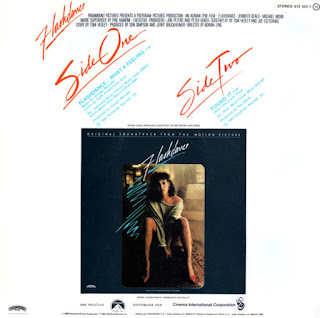IRENE CARA - FLASHDANCE… WHAT A FEELING
Estrena: març de 1983
Llistes: Regne Unit: #2 EUA: #1 (6 setmanes)
"Flashdance... What a Feeling" és una cançó destacada a la pel·lícula "Flashdance" del 1983, amb música composada per Giorgio Moroder i lletra escrita per Keith Forsey i Irene Cara, qui també va interpretar la cançó. Moroder va ser l'encarregat de compondre la música per a la pel·lícula, i Cara i Forsey van col·laborar en les lletres després de veure l'última escena, on el personatge principal realitza una audició de ball davant d'un grup de jutges. Inspirats per la determinació de la ballarina a tenir èxit, van intentar transmetre la sensació de ser motivat per la música per seguir els seus somnis. La cançó es va convertir en sinònim de la pel·lícula, sonant durant escenes cabdals com l'audició i els crèdits d'obertura, on es mostra el personatge principal treballant com a soldadora.
La col·laboració de Giorgio Moroder amb el productor Jerry Bruckheimer en la pel·lícula "American Gigolo" del 1980 va obrir pas a la seva associació a "Flashdance". Bruckheimer es va apropar a Moroder el 1982 perquè composés la música per a la nova pel·lícula, que girava al voltant del personatge Alex Owens i les seves aspiracions de ser ballarina. Inicialment, Moroder es va mostrar reticent per altres compromisos, però finalment va proporcionar un esbós de música que creia que podria adaptar-se al projecte. Aquesta maqueta va acabar evolucionant cap a "Flashdance... What a Feeling." Moroder va acceptar oficialment compondre la música després de veure un muntatge preliminar de la pel·lícula. Va encarregar la tasca d'escriure les lletres al seu bateria de sessió, Keith Forsey, que inicialment va treballar en les lletres de manera independent abans de rebre l'ajuda d'Irene Cara.
Tot i la absència de la paraula "Flashdance" a la lletra, la cançó "Flashdance... What a Feeling" està íntimament vinculada al tema de ballar i expressar-se de la pel·lícula. Irene Cara, una ballarina talentosa, va afirmar que l'essència de la cançó és metafòrica, il·lustrant el sentiment d'empoderament i control d'una ballarina sobre el seu cos i la seva vida.
La pel·lícula "Flashdance" es va estrenar el 15 d'abril de 1983. El 28 de maig, aquesta cançó va arribar al número 1 als Estats Units, on es va mantenir durant sis setmanes. El 25 de juny, la banda sonora també va arribar al número 1 i es va mantenir durant dues setmanes, interrompent l'èxit de "Thriller" de Michael Jackson, que havia estat al capdamunt durant 17 setmanes i tornaria per a 20 més (eventualment, superat per la banda sonora de "Footloose"). El 10 de setembre, una altra cançó de "Flashdance", "Maniac" de Michael Sembello, també va arribar al número 1 als Estats Units.
La selecció de "Flashdance... What a Feeling" per part de la Biblioteca del Congrés per a la preservació al Registre Nacional d'Enregistraments el 2023 posa de relleu la seva "importància cultural, històrica o estètica en el patrimoni sonor enregistrat de la nació".
IRENE CARA - FLASHDANCE… WHAT A FEELING
Released: March 1983
Charted: UK: #2 US: #1 (6 weeks)
"Flashdance... What a Feeling" is a song featured in the 1983 film Flashdance, with music composed by Giorgio Moroder and lyrics penned by Keith Forsey and Irene Cara, who also performed the song. Moroder was tasked with scoring the film, and Cara and Forsey collaborated on the lyrics after viewing the last scene, where the main character performs a dance audition before a panel of judges. Inspired by the dancer's drive to succeed, they aimed to convey the feeling of being motivated by music to pursue one's dreams. The song became synonymous with the film, playing during pivotal scenes such as the audition and the opening credits, which depict the main character working as a welder.
Giorgio Moroder's collaboration with producer Jerry Bruckheimer on the 1980 film American Gigolo paved the way for their partnership on Flashdance. Bruckheimer approached Moroder in 1982 to compose the music for the new film, which centered around the character Alex Owens and her aspirations of becoming a ballerina. Initially hesitant due to other commitments, Moroder eventually provided a rough sketch of music that he felt might suit the project. This demo eventually evolved into "Flashdance... What a Feeling." Moroder officially agreed to compose the score after viewing a rough cut of the film. He entrusted the task of writing the lyrics to his session drummer, Keith Forsey, who initially worked on the lyrics independently before receiving assistance from Irene Cara.
Despite the absence of the word "Flashdance" in the lyrics, the song "Flashdance... What a Feeling" is intricately linked to the film's theme of dancing and self-expression. Irene Cara, a talented dancer in her own right, conveyed that the song's essence is metaphorical, illustrating a dancer's sense of empowerment and control over both her body and her life.
The movie Flashdance was released on April 15, 1983. On May 28, this song hit #1 US, where it stayed for six weeks. On June 25, the soundtrack when to #1 and stayed for two weeks, interrupting the run of Michael Jackson's “Thriller” which had been at the top spot for 17 weeks and would return for another 20 (eventually knocked off by the Footloose soundtrack). On September 10, another song from Flashdance, Michael Sembello's "Maniac” also went to #1 US.
"Flashdance... What a Feeling" being selected by the Library of Congress for preservation in the National Recording Registry in 2023 highlights its "cultural, historical, or aesthetic importance in the nation’s recorded sound heritage."





































